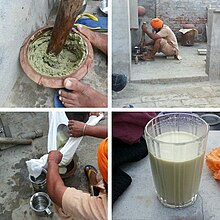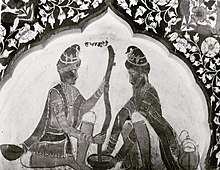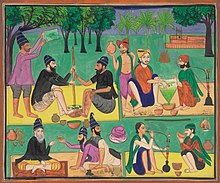
In Sikhism, some Sikhs particularly of the Nihang community use edible cannabis in a religious context. They make use of cannabis by ingestion. It is used to make a drink called "Shaheedi Degh" which is meant to help Nihang Singhs become highly present in the moment. Nihang Singhs used marijuana in the early times of Sikh history during times of battle, it is believed to help them become more fierce warriors.
Prohibition

The first Sikh guru, Guru Nanak, stated that using any mind altering substance (without medical purposes) is a distraction from God. Guru Nanak was offered bhang by the Mughal emperor Babur; Nanak however declined, and recited this shabad:
Fear of Thee, o Lord, is my bhang, and my mind the pouch in which I carry it. Intoxicated with this bhang I have abandoned all interest in worldly concerns.
The SGPC has also added a section in their rehait maryada (Sikh codes of conduct) that bans the Cannabis, opium and liquor for all Sikhs that follow its rehit maryada. The following is a translated quote from the rehait maryada. "A Sikh must not take hemp (cannabis), opium, liquor, tobacco, in short, any intoxicant. His only routine intake should be food."
Usage

The Sikhs inherited the tradition of drinking originates from the sixth Sikh Guru, Sri Guru Hargobind Sahib ji who started it to give sikhs Bir Ras (warrior spirit) and to get them energized, as sikhs used to get up at around 12 am for armit vela and not go back to sleep till after the evening prayers of Sohila Sahib.
ਬਿਦਿਹ ਸਾਕੀਯਾ ਸਾਗ਼ਰੇ ਸਬਜ਼ ਗੂੰ ॥
‘Oh! Saki Give me the cup full of green (liquid)
ਕਿ ਮਾਰਾ ਬਕਾਰਸਤ ਜੰਗ ਅੰਦਰੂੰ ॥੨੦॥
‘Which I need at the time of struggle(20)
ਲਬਾਲਬ ਬਕੁਨ ਦਮ ਬਦਮ ਨੋਸ਼ ਕੁਨ ॥
‘Fill it up to the brim so that I can drink it with every breath
ਗ਼ਮੇ ਹਰ ਦੁ ਆਲਮ ਫ਼ਰਾਮੋਸ਼ ਕੁਨ ॥੨੧॥੧੨॥
‘And forget the afflictions of both the worlds(21)(12)
(Dasam Guru Granth Sahib, Ang 1428)
Nihang Sikhs
In the modern day, cannabis consumption (but not smoking) is commonly associated with the Nihang Singhs, a sect who continue the orthodox Sikh warrior tradition, who consume drinks as sukha or sukhnidhaan, or more commonly known shaheedi degha. shaheedi degh is mostly used in Panjab on the Sikh holidays of Holla Mohalla and Vaisakhi. At many Sikh temples, including Takht Sachkhand Sri Hazur Sahib Ji, the shaheedi degh is offered as a holy food.
In 2001, Baba Santa Singh, the jathedar of Budha Dal, along with 20 Nihang jathadars (leaders), refused to accept the ban on the consumption of bhang by the SGPC. Baba Santa Singh was excommunicated for a different issue, and replaced with Balbir Singh (who isn't accepted to be a nihang leader by most nihang singhs), who agreed to shun the consumption of bhang.
Some Nihang groups consume cannabis or shaheedi degh (ਭੰਗ), purportedly to help in meditation. Sukhaa-parsaad (ਸੁੱਖਾਪ੍ਰਰਸਾਦ), "dry-sweet", is the term Nihang use to refer to it. It was traditionally crushed and taken as a liquid, especially during festivals like Hola Mohalla.
See also
References
- Ayyagari S (2007). ""Hori Hai": A Festival of Colours!! (review)". Asian Music. 38 (2). Johns Hopkins University Press: 151–153. doi:10.1353/amu.2007.0029. S2CID 192201145.
- McLeod (4 March 2004). Sikhs and Sikhism: Comprising Guru Nanak and the Sikh Religion, Early Sikh Tradition, The Evolution of the Sikh Community, Who is a Sikh?. OUP India. pp. 74–75. ISBN 978-0-19-566892-6.
- "SikhiToTheMax". www.sikhitothemax.org. Archived from the original on 2022-11-05. Retrieved 2022-11-05.
- Pashaura Singh; Louis E. Fenech (March 2014). The Oxford Handbook of Sikh Studies. OUP Oxford. pp. 378–. ISBN 978-0-19-969930-8.
- Pashaura Singh; Michael Hawley (7 December 2012). Re-imagining South Asian Religions: Essays in Honour of Professors Harold G. Coward and Ronald W. Neufeldt. BRILL. pp. 34–. ISBN 978-90-04-24236-4.
- "The 'Sukhnidhaan' or 'Bhang' (cannabis)". Amrit World. 28 February 2008. Archived from the original on 20 November 2015. Retrieved 19 November 2015.
- Nihangs ‘not to accept’ ban on bhang Archived 2016-03-03 at the Wayback Machine. The Tribune. March 26, 2001.
- No ‘bhang’ at Hola Mohalla Archived 2015-12-08 at the Wayback Machine. The Tribune. March 10, 2001.
| Cannabis and religion | |
|---|---|
| By religion | |
| Movements | |
| Historical | |
| People | |
| Related | |